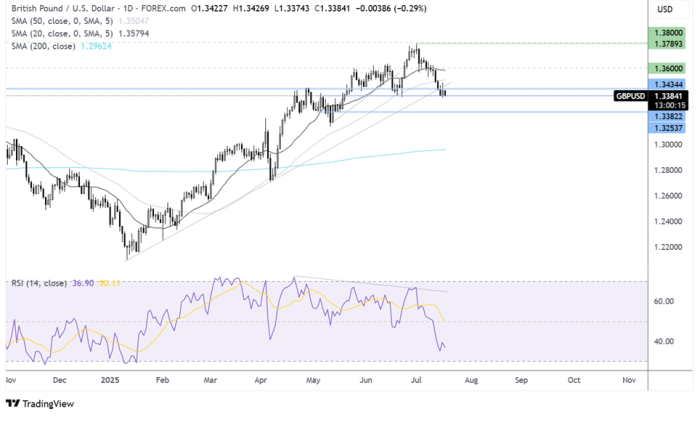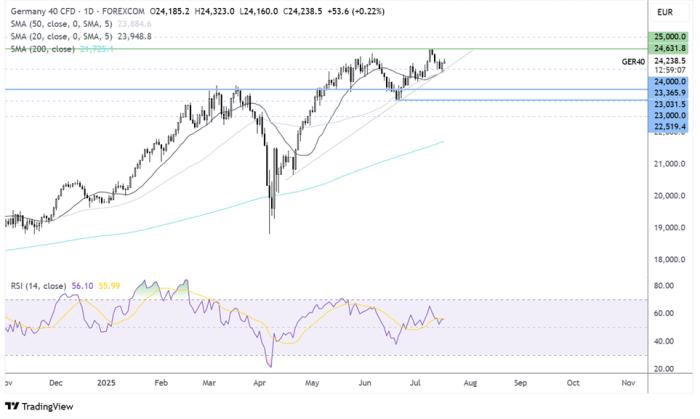- UK unemployment rises to 4.7% vs 4.6%
- Wage growth slows to 5% and payrolls fall by 41k
- tests 1.3375 support
GBP/USD is falling on pound weakness as UK wage growth slows and hits a four-year high. Data from the Office for National Statistics showed that unemployment rose to 4.7% in the three months to May, the highest level since 2021 and up from 4.6% previously. The data also showed that employers cut the number of staff on payrolls by 41,000 in June, worse than expected, and pay growth excluding bonuses fell to 5% in the same period.
The jobs market has weakened significantly since the government’s Budget, which increased the tax burden on employers.
Job cuts, higher unemployment, and weaker pay growth came after hotter-than-expected yesterday, highlighting the challenge the Bank of England faces.
Earlier in the week, Bank of England governor Andrew Bailey warned that the central bank may need to more aggressively if the jobs market continued to weaken. This suggests that the central bank sees the spike in inflation as a temporary occurrence.
Yesterday, Bank of England policymaker Catherine Mann warned that unemployment prompts UK households to save rather than spend and that this consumer behaviour is leading to lower growth in certain sectors, including hospitality and retail.
Meanwhile, the is rising, recovering from losses yesterday after Trump soothed concerns surrounding Federal Reserve chair Jerome Powell, stating that he wasn’t going to fire him. Remove from yesterday’s session that Trump was on the verge of firing Powell, which sent the US dollar sharply lower.
Attention is turning to US and . are expected to rise 0.1% MoM, up from -0.9% and are expected to increase to 235K, up from 227k. Stronger-than-forecast data could support the USD higher.
GBP/USD Forecast- Technical Analysis
GBP/USD is testing support at 1.3375, having fallen from its 3.5-year high of 1.3790 and taken out several key support levels that have turned into resistance at 1.36, 1.35, and 1.3435, the September 2024 high, as well as rising trendline support.
Sellers, supported by the RSI below 50, will look to break below 1.3375 to create a lower low and extend the selloff towards 1.3250, the May low.
Any recovery would need to rise above 1.3450 and 1.35. A rise above 1.36 would create a more constructive outlook.

Rises on Trade Hopes, Tech Rebounds
- EU-US trade deal optimism lifts DAX
- EZ CPI is expected to confirm 2.3%
- DAX rises from 24k support, snapping a 5-day losing streak
The DAX is pushing higher on Thursday, ending a five-day losing streak, boosted by optimism over a potential US-EU trade deal and upbeat corporate earnings.
News that US and EU firms have agreed on a major gas deal is fueling speculation for a broader US-EU trade agreement.
The EU chief trade negotiator, Sefcovic, is heading to Washington next week for high-level talks aimed at securing a deal ahead of Trump’s August 1st deadline.
Upbeat earnings from Taiwan Semiconductor Manufacturing (NYSE:) have fueled a recovery in chip stocks, which had been under pressure the day before after a growth warning from ASML (NASDAQ:). Seamans, Seamans Energy, Infineon Technologies, and SAP were among the stocks leading the DAX higher, trading between 1.4% and 3.6%.
Automakers and pharmaceutical stocks are also posting solid gains, driven by optimism about the trade deal.
On the data front, attention will be on eurozone figures, which are expected to confirm the preliminary reading of 2.3% annually. The ECB is expected to leave the unchanged at 2% next week as policymakers wait to assess the impact of Trump’s trade tariffs. The ECB is still expected to cut rates once more this year.
DAX Forecast – Technical Analysis
The DAX has extended its recovery from the 23k June low, before running into resistance at 24,650 a record high last week. The price has eased back from this level, finding support around 24k, a round number, the 50 SMA, and a rising trendline.
Buyers, supported by the RSI above 50, will look to rise above 24,650 to create a higher high.
Sellers would need to take out the 24k support zone to extend losses towards 23,400, the March high. Below here, 23k comes into play.



